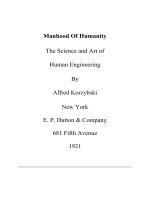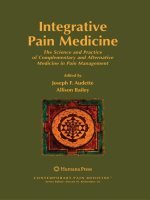- Trang chủ >>
- Khoa Học Tự Nhiên >>
- Vật lý
bridges the science and art of the worlds most inspiring structures mar 2010
Bạn đang xem bản rút gọn của tài liệu. Xem và tải ngay bản đầy đủ của tài liệu tại đây (2.43 MB, 329 trang )
BRIDGES
This page intentionally left blank
BRIDGES
The Science and Art of the
World’s Most Inspiring Structures
David Blockley
1
3
Great Clarendon Street, Oxford ox26dp
Oxford University Press is a department of the University of Oxford.
It furthers the University’s objective of excellence in research, scholarship,
and education by publishing worldwide in
Oxford New York
Auckland Cape Town Dar es Salaam Hong Kong Karachi
Kuala Lumpur Madrid Melbourne Mexico City Nairobi
New Delhi Shanghai Taipei Toronto
With offices in
Argentina Austria Brazil Chile Czech Republic France Greece
Guatemala Hungary Italy Japan Poland Portugal Singapore
South Korea Switzerland Thailand Turkey Ukraine Vietnam
Oxford is a registered trade mark of Oxford University Press
in the UK and in certain other countries
Published in the United States
by Oxford University Press Inc., New York
# David Blockley 2010
The moral rights of the authors have been asserted
Database right Oxford University Press (maker)
First published 2010
All rights reserved. No part of this publication may be reproduced,
stored in a retrieval system, or transmitted, in any form or by any means,
without the prior permission in writing of Oxford University Press,
or as expressly permitted by law, or under terms agreed with the appropriate
reprographics rights organization. Enquiries concerning reproduction
outside the scope of the above should be sent to the Rights Department,
Oxford University Press, at the address above
You must not circulate this book in any other binding or cover
and you must impose the same condition on any acquirer
British Library Cataloguing in Publication Data
Data available
Library of Congress Cataloging in Publication Data
Library of Congress Control Number: 2009942577
Typeset by SPI Publisher Services, Pondicherry, India
Printed in Great Britain
on acid-free paper by
Clays Ltd, St Ives Plc
ISBN 978 0 19 954359 5
13579108642
Contents
List of Illustrations vii
Acknowledgements xi
Introduction xv
1. Bridges Are BATS:
Why we build bridges 1
2. Underneath the Arches:
Bridges need good foundations 36
3. Bending It:
Bridges need strong structure 74
4. AllTrussedUp:
Interdependence creates emergence 111
5. LetItAllHangDown:
Structuring using tension 149
6. How Safe is Safe Enough?:
Incomplete science 206
7. Bridges Built by People for People:
Processes for joined-up thinking 242
Endnotes 281
Glossary 293
Bibliography 297
Index 301
This page intentionally left blank
List of Illustrations
1. London Millennium Bridge 3
2. Shear force 20
3. I beams and other components 20
4. Forth Railway Bridge 26
5. Michelangelo sketch of brid ge scaffold for painting
of the Sistine Chapel 31
6. Author’s sketch of the truss bridge used in the
restoration of the Sistine Chapel from 1981 to 1994 33
7. Masonry Arch Bridge at Bradford on Avon
near Bath, UK 37
8. Centring for the Salginatobel Bridge,
Switzerland 38
9. Behaviour of a corbel wall 45
10. The forces in a masonry arch 50
11. Ironbridge at Coalbrookdale, UK 56
12. Brunel’s Saltash Bridge 58
13. The Salginatobel Bridge, Switzerland 67
14. The Clyde Arc Finnieston Bridge, Glasgow 68
15. Clapper Bridge, Tarr Steps Exmoor, UK 76
16. The underside of the Second Severn
Crossing approach spans 81
17. The deflected shapes of beams 84
18. Internal forces in a beam 87
vii
19. Bending moment and shear force diagrams for
a simply supported beam 92
20. Bending moment and shear force diagrams
for a two-span continuous beam 94
21. Internal forces in a modern arch 102
22. Some forms of truss 117
23. Internal forces at three cuts in a king post truss 121
24. Internal tension force in rafter of truss 122
25. Triangle of forces 124
26. Internal forces in a Pratt truss 130
27. Erection of a leg of the Forth Railway Bridge 134
28. Caisson of Forth Railway Bridge 136
29. Types of weld: (a) fillet weld and
(b) butt weld 141
30. Flisa Bridge, Norway 147
31. Snowy Creek Bridge, New Zealand 151
32. Types of hanging bridges 154
33. Millau Viaduct, France 155
34. Pont de Normandie 156
35. Deflections of tension cable 159
36. Internal forces in suspended cable 161
37. Brooklyn Bridge, New York 167
38. Cross sections of Brooklyn Bridge 171
39. Internal forces in a suspension bridge 173
40. Internal forces in a cable-stayed bridge 194
41. The Goodwill Bridge, Brisbane, Australia 201
42. Miho Bridge, Japan 202
43. Puente del Alamillo, Seville, Spain 204
44. Internal stresses in a beam 213
45. Coordinate axes 220
viii
LIST OF ILLUSTRATIONS
46. Distribution of load versus strength 222
47. Plastic hinges 227
48. Turning on a tap 258
49. Integrating processes for bridge building 261
50. Feedback for learning 275
ix
LIST OF ILLUSTRATIONS
This page intentionally left blank
Acknowledgements
Very many people have helped me prepare this book. Firstly I
owe an enormous debt to Joanna Allsop, who made many sug-
gestions to make the book accessible to non-technical readers. She
read every word and pointed me to the material on Michelangelo’s
bridge building in the Sistine Chapel.
Robert Gregory and Mike Barnes read the whole book and also
made many helpful comments. Ian Firth, John Macdonald, and
Jolyon Gill read Chapter 5 and advised me on the dynamics of
footbridges. Pat Dallard, Michael Willford, and Roger Ridsdill-
Smith read and made helpful suggestions to ground my account
of the problems with the London Millennium Bridge in the
experience of those who took part. David Weston has provided
information about the Bradford on Avon Arch Bridge.
I thank Robert and Ros Gregory for being such good and
remarkably patient travelling companions on our bridge-photo-
graphing tours in Europe the photographs Figures 13, 33, 34,
and 43 were taken by Robert. I thank Ian May for Figure 4, David
Elms for Figure 31, Timothy Bailey for Figure 14, and Mitsuyuki
Hashimoto and Dr Hisato Kato for Figure 42. My thanks to
Leonardo Ferna
´
ndez Troyano who kindly allowed me to use
his picture of the Brooklyn Bridge (Figure 37). David Nethercot,
Alistair Walker, and Peter Lewis helped me interpret the evidence
regarding the failure of the Dee Bridge. Colin Brown has long
xi
been a personal mentor and provided material regarding floating
bridges in Washington State, USA. Michael Liversidge very
kindly and helpfully commented on my attempts to categorize
bridges as art and on my sketch for Figure 6, which is based
on very limited published material. Richard Buxton suggested
I might find material in Herodotus and I did. Patricia Rogers
tracked down so much material for me in the University of
Bristol Library. Thank you also to the many others who helped
directly or indirectly through their conversations, particularly
Joan Ramon Casas, Priyan Dias, David Elms, David Harvey,
Lorenzo Van Wijk, Guido Renda, Albert Bernardini, Arturo
Bignoli, Bob McKittrick, Adam Crewe, Jitendra Agarwal, Mike
Shears, Malcolm Fletcher, and Michael Dickson. I send a special
word of thanks to Roy Severn and Patrick and Trudie Godfrey for
their direct help and encouragement.
I acknowledge permission from the Uffizzi Gallery Florence to
use Figure 5; the photo archives of Andreas Kessler, Igis, Switzer-
land for Figure 8; the Institution of Civil Engineers for Figure 30;
and the American Society of Civil Engineers for allowing me to
base my drawings for Figure 38 on the diagrams in ASCE Proceedings
72 (1946).
I thank the following for permission to quotesextracts: Burlington
Magazine for text by John Beldon Scott; Penguin Books for material
from Herodotus, The Histories; the Institution of Structural Engin-
eers for text from the Presidential address by Oleg Kerensky; Simon
Caulkin for material from an article in the Observer newspaper; and
Michael E McIntyre for text from his website.
Particular thanks to David Doran for encouraging me to write
this book and, through him, to Keith Whittles. Thanks also to
Emma Marchant and Fiona Vlemmiks at Oxford University Press
ACKNOWLEDGEMENTS
xii
and copy editors Charles Lauder Jr. and Paul Beverley. However,
the biggest thanks of all go to OUP editor Latha Menon, firstly for
having faith in me when she saw my first draft and then for
guiding and eventually commissioning the book and for helping
to develop it into something worth publishing.
Last, but by no means least, thanks to my wife, Karen, for her
long suffering during the gestation, writing, and production of the
book and her unfailing love and support and endless cups of tea.
xiii
ACKNOWLEDGEMENTS
This page intentionally left blank
Introduction
Bridges touch all our lives every day we are likely to cross or go
under a bridge. But how many of us stop to consider how the
bridge works and what sort of people designed and built it? In
this book we will explore how we can read a bridge like a book,
to understand how it works, and to appreciate its aesthetic, social,
and engineering value.
There are three practical requirements for a successful
bridge firm foundations, strong structure, and effective work-
ing. These will form the ‘chapters’ within which we will find
‘paragraphs, sentences, words, and letters’. The ‘grammar’ of
how bridges are put together will be based on combinations of
four substructural types BATS beams, arches, trusses, and
suspensions. For example, the Golden Gate Bridge is a suspension
Bridge with a roadway deck on a stiff truss beam.
Bridges are icons for whole cities think of New York’s Brook-
lyn B ridge, Sydney’s Harbour Bridge, and Brunel’s Clifton Bridge in
Bristol where I live. Traditionally architects have not been involved
in bridge design because bridges have been conceived as ‘raw’
engineered structure. Yet bridges are also a form of functional public
art they can delight or be an eyesore. Now architects and sculptors
can and do contribute to the aesthetics of bridges to improve their
impact in our public spaces. One of the finest examples is the Millau
Viaduct in France which certainly has the ‘wow’ factor.
xv
Bridge building is a magnificent example of the practical
and everyday use of science. Unfortunately there are always gaps
between what we know, what we do, and why things go wrong.
Bridge engineers must manage risks carefully. They know that
information has a ‘pedigree’ which they must understand. The
rare cases of bridge failures can help us to learn some valuable
lessons that also apply to other walks of life. One example is that
failure conditions can incubate over long periods and we can
learn to spot them. Another is that partial or ‘silo’ thinking with a
lack of ‘joined-up’ inadequate processes do typify technical and
organizational failures.
The first chapter focuses on why bridges are important and
set out the basic BATS grammar that we will use to read them.
Chapters 2 5 describe how arches, beams, trusses, and suspen-
sion cables work, using real and specific examples. Arches are
symbols of stability. Beams bend flexibly. Trusses are physical
teamwork. Suspension bridges are often landmark structures.
Chapter 6 sets out the role of scientific models and managing
risks and addresses the question ‘How safe is safe enough?’
The final chapter shows how pragmatic systems thinking is
natural for bridge builders. They use practical rigour which is not the
same as scientific logical rigour. Logical rigour is necessary but not
sufficient for practical success. Bridge engineers also build people
bridges asthey form and reform teams to accomplish t heir successes.
We will synthesize the lessons from bridge building and show how
they feed into problems where ‘joined-up’ thinking is needed.
There are many books published about bridges. This book is
different in that it is a rare, indeed the only example as far as I am
aware, attempt to help nontechnical readers understand the
technical issues that bridge builders have to face.
INTRODUCTION
xvi
1
BRIDGES ARE BATS
Why We Build Bridges
‘Architects are a strange breed,’ wrote BBC’s Andrew Walker in
2002. Hewas referring to British architect Lord Foster who, accord-
ing to Walker, designed the famously ‘wobbly’ London Millennium
Bridge. ‘No other profession stamps its personal style on ourlives in
the way that theirs does,’ he said.
1
Jonathan Duffy, also from the
BBC, writing in 2000 had anticipated his colleague’s comments. ‘As
the Millennium Bridge shows, modern architecture is anything but
a breeze. At the cutting edge, uncertainty is an occupational haz-
ard.’ He continued: ‘It [the bridge] was supposed to be a blade of
light shooting across the Thames.’
2
For the ‘hordes’ crossing at the
opening ‘the experience was more like a rickety fairground ride.’
Nowhere in the article did Duffy mention the real technical
designers of the bridge who did most of the work the structural
engineers, Arup. Indeed he attributed the complex calculations
and computer models to Foster when in fact Arup had done
them and got them right but the bridge still wobbled.
So what went wrong? Should Arup be blamed for designing a
bridge that manifestly didn’t do its job? Innovation is always
risky but without risk we don’t advance. Did Arup take too
many risks in a single leap?
1
Arup is one of the leading firms of structural engineers in the
world. They knew that when they had a wobbly bridge, they just
had to put it right and they did so. It’s now as steady as a rock
and a real landmark.
The reason for the wobble is interesting. I was part of the
crowd invited to test the bridge before it was reopened in 2002.
Several hundred of us processed back and forth as its movements
were measured. Arup had fitted shock absorbers and wanted to
check that they would prevent the wobbles and they did.
Afterwards I took a taxi back to the Institution of Structural
Engineers HQ where I was staying as President for 2001 2. I told
my taxi driver what I had been doing. He said, ‘Typical ain’t it?
We Brits can’t even get a bridge right.’ As a structural engineer
I felt defensive. I told him that the wobble was a different kind
of wobble to the well-known vibrations created by soldiers
marching. The engineers knew that soldiers marching in step
caused vibrations and had correctly done extensive calculations
for that kind of wobble. The problem was that this wobble was
a sideways one that hadn’t really been recognized before. ‘It’s
called synchronous lateral excitation’, I said. He didn’t ask me
to explain anymore because by then we had arrived at my
destination.
The story of the wobbly bridge that no longer wobbles is a
classic example of real progress in knowledge being made arising
from something unforeseen going wrong.
In 1996 the Financial Times newspaper and Southwark Council
organized a competition to design a new footbridge across the
Thames. The winning team was Arup, Foster and Partners with
sculptor Sir Anthony Caro. Their design decisions were con-
trolled by the architectural vision of the bridge as a ‘blade of
BRIDGES ARE BATS
2
light’ a vision to which all members of the team contributed.
A suspension bridge was, from a structural point of view, un-
likely to be the most economic solution but it suited the overall
concept. The team chose an unusual form of shallow suspension
bridge where the tensioning cables are, as far as possible, below
the deck level so that all views were unobstructed. In fact the
cables sag around six times less than those of a conventional
suspension bridge. The team decided on three main spans of 81,
144, and 108 m from north to south (Figure 1). The bridge deck
was designed and built with steel box arms spanning between
the cables every 8 m. The deck structure has two steel edge tubes
supported by the arms and the 4-m-wide deck is of aluminium.
Two piers were built to support the bridge from the river bed and
fig 1. London Millennium Bridge
BRIDGES ARE BATS
3
the eight suspension cables pull against the abutments set into
each bank with enough force to support 5,000 people on the
bridge.
The shallowness of the cables means that the pulling tensions
in the cables are higher than normal, making the bridge taut and
highly strung. They act rather like the strings of a violin. When
a violinist tightens a violin string to make the note higher
that makes it vibrate at a higher frequency so that the strings
move backwards and forwards through repeated cycles at a
higher rate.
All bridges and other structures, including the human body,
have what scientists call a natural frequency when objects
vibrate freely. Bridges with spans similar to the London Millen-
nium Bridge typically vibrate with natural frequencies between
0.5 and 1.0 cycles per second. If wind or pedestrians apply forces
to the bridge at the same frequency as the natural frequency then
resonance occurs and the vibrations can become very large
indeed. When we walk across a bridge we push down with
each step but we also push outwards slightly as well. The struc-
tural engineers did extensive calculations and thought that they
had all these possible sources of wobble covered.
The bridge opened on 10 June 2000. It was a fine day and the
bridge was onthe route of a major charity walk. There were around
90,000 users on that first day with up to 2,000 on the bridge at any
one time. The bridge swayed from side to side unexpectedly and
was closed two days later. It was dubbed the ‘wobbly’ bridge by the
media who declared it another high-profile British Millennium
Project failure. Not everyone agreed some people were reported
as saying that they enjoyed the swaying around and one even said it
was a shame the bridge wasn’t more wobbly.
BRIDGES ARE BATS
4
So what do engineers do in the face of such a public problem?
Arup decided to tackle the issue head on. They immediately under-
took a fast-track research project to seek the cause and the cure.
Measurements were made in university laboratories of the effects
of people walking on swaying platforms. Large-scale experiments
with crowds of pedestrians were made on the bridge itself. From all
of this work, involving a number of people and organizations, a
new understanding and a new theory were developed.
The unexpected motion was the result of a natural human
reaction to small lateral movements. If we walk on a swaying
surface we tend to compensate and stabilize ourselves by spread-
ing our legs further apart but this increases the lateral push. Pat
Dallard, the engineer at Arup who was a leading member of the
team who developed the new theory, says that you change the
way you walk to match what the bridge is doing. It’s rather like
walking on a rolling ship deck you move one way and then the
other to compensate for the roll. The way people walk doesn’t
have to match exactly the natural frequency of the bridge as in
resonance the interaction is more subtle. As the bridge moves,
people adjust the way they walk in their own manner. The
problem is that when there are enough people on the bridge
the total sideways push can overcome the bridge’s ability to
absorb it. The movement becomes excessive and continues to
increase until people begin to have difficulty in walking they
may even have to hold on to the balustrades. One of the diffi-
culties is that there is no sign of any trouble until a ‘critical
number’ of pedestrians are on the bridge. In tests on one span
of the London Millennium Bridge, there was no sway at all with
156 walkers on it, but when 10 more walked on it a wobble started
and increased rapidly.
BRIDGES ARE BATS
5
The intense media publicity brought to light some previous
eyewitness accounts of this kind of wobble. Examples in the 1970s
included UK bridges at the National Exhibition Centre and
in Chester and also the Auckland Harbour Road Bridge, New
Zealand, during a Maori demonstration. One month after the
Millennium Bridge opened a 100-year-old road bridge in Ottawa
wobbled as a huge crowd left the bridge. The Golden Gate Bridge
on the day of its opening and the Brooklyn Bridge during a power
outage have both also suffered. A colleague at the University of
Bristol, John Macdonald, has recently measured similar move-
ments on Brunel’s Clifton Suspension Bridge in Bristol.
The only documented technical study before the millennium
celebrations was in 1993 by a Japanese team lead by Yozo Fujino
of the University of Tokyo. In a technical research paper they
wrote, ‘It seems that human-induced lateral vibration has not
been checked in designing pedestrian bridges.’
3
They reported
experiments on a cable-stayed pedestrian bridge next to a boat
race stadium. After a race as many as 20,000 people passed over
the bridge in 20 minutes. The Japanese team produced evidence
demonstrating synchronized walking and lateral vibration of the
bridge. Unfortunately the paper was published in a research
journal about earthquake engineering rather than one directly
concerned with bridges an illustration of the difficulty of shar-
ing this kind of information.
The solution to stop the wobble of the London Millennium
Bridge was to install shock absorbers, rather like in a car. Using
the results of their quantitative research the engineers designed a
system of 37 shock absorbers called ‘viscous dampers’ and 54
weights attached to the bridge by springs to dampen the vertical
motion. The research and design process took over four months.
BRIDGES ARE BATS
6
The actual work cost over £5m and the bridge was reopened on
22 February 2002. With some style, Arup organized an opening
concert and commissioned a special piece of music for the
occasion called Crossing Kings Reach by Peter Maxwell Davies.
So, the particular wobbles of the wobbly bridge were not
anticipated by the engineering designers. They had missed the
Japanese research. Although the phenomenon had been seen
before by a few researchers it hadn’t been recognized sufficiently
as something that bridge designers should be looking for and it
had not found a place in any bridge design codes, manuals, or
journals. The phenomenon was rare because the susceptible
bridges had not experienced the critical number of pedestrians.
The problem was that there is nothing to see until you get a big
crowd and that may simply not happen.
Bridge builders now realize that potentially this can happen to
any long bridge carrying pedestrians. According to the latest theory
the ‘critical num ber’ of people above which these wobbles w ill
occur depends on the weight of the bridge, its natural frequency,
and the amount of damping (i.e. the degree to which the bridge has
‘built-in’ shock absorbers). Larger bridges are more like double
basses than violins and so will have lower natural frequencies.
Many bridges will be heavier than the Millennium Bridge though
the level of damping will vary, depending on the individual design.
This means that the critical number of people to make a given
bridge wobble will usually be larger than was originally the case
for the Millennium Bridge. The ‘cure’ was to increase the damp-
ing to a level where the critical number of people is more than
can reasonably actually get onto the bridge.
Although these kinds of wobbles can occur on any long bridge
they were, and still are, very rare. Arup’s design did not cause the
BRIDGES ARE BATS
7
wobble because of its innovative structural form; the wobble
arose as a result of the large number of people and insufficient
damping in the structure. So the popularity of the bridge on its
opening day put a spotlight on the susceptibility of all bridges. As
a result the phenomenon has now been researched to a point that
future bridge designers will be able to take it into account. Cer-
tainly, bridge owners need to take advice if there is a chance that
very large numbers of people might congregate on their bridge.
So were Arup to blame? The simple answer is ‘no’. Arup were
responsible but not blameworthy an important distinction.
They followed best practice but best practice was not good
enough. When designers innovate there is a need to take great
care in checking for new and, unintended consequences. Bridge
building is a risky business and, as we will discover in Chapter 6,
the risk of unintended and unwanted events is always present.
One could argue that the whole issue of the wobbly bridge was
cultural and not technical. The problem might have been
avoided if people’s expectations had been managed differently.
There are bridges across the world that do wobble a great deal
but in those cases pedestrians are warned before they cross and
so they know what to expect. The wobbles of the Millennium
Bridge would not have caused it to collapse (although its life may
have been curtailed due to metal fatigue) so there was no threat
to life. If the bridge had been designed expecting it to wobble and
people were warned of the possibility then all of the fuss made
wouldn’t have happened. There might well have been complaints
but as we shall see in Chapter 5, the Capilano Bridge north of
Vancouver is very wobbly and the Carrick-a-Rede rope bridge in
County Antrim, Northern Ireland, is said to be so bouncy it’s a
tourist’s challenge! Forewarned is forearmed.
BRIDGES ARE BATS
8









